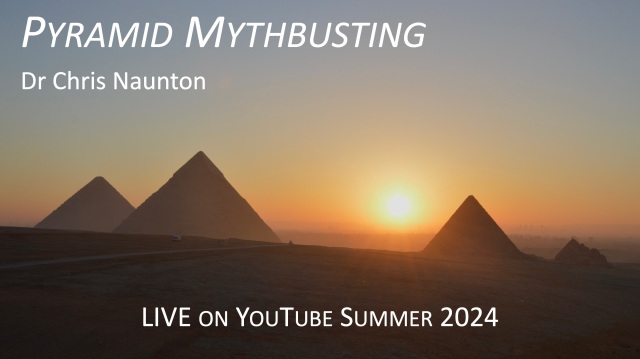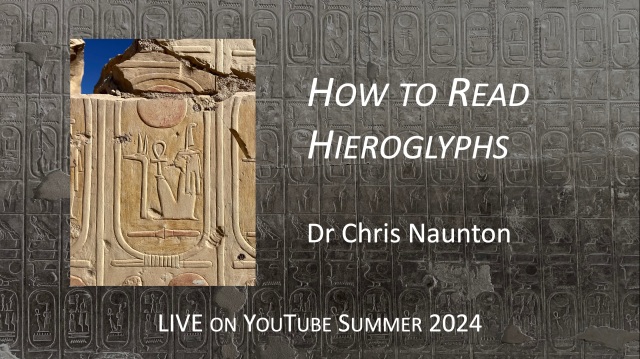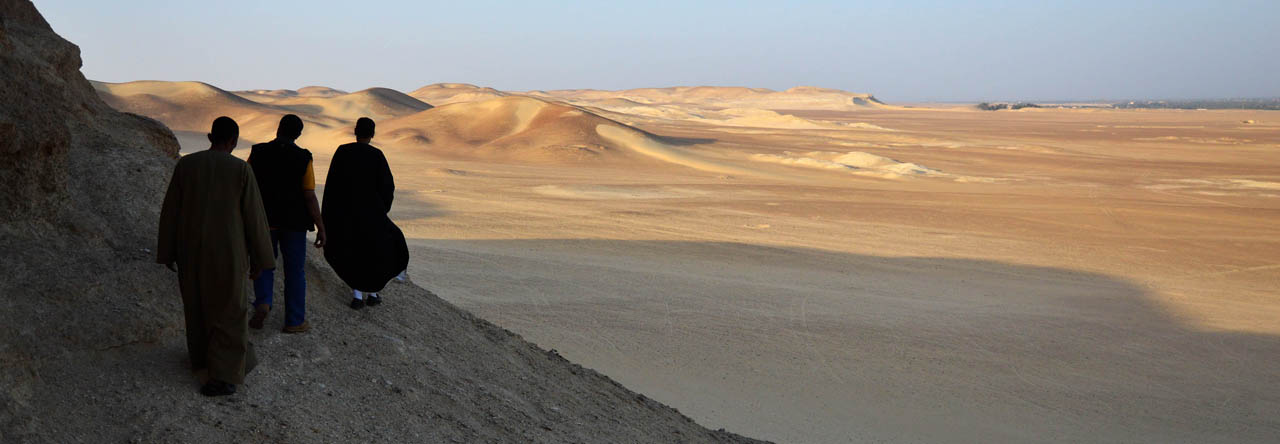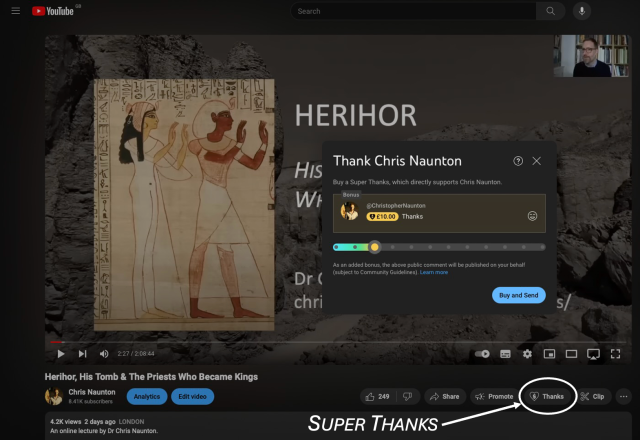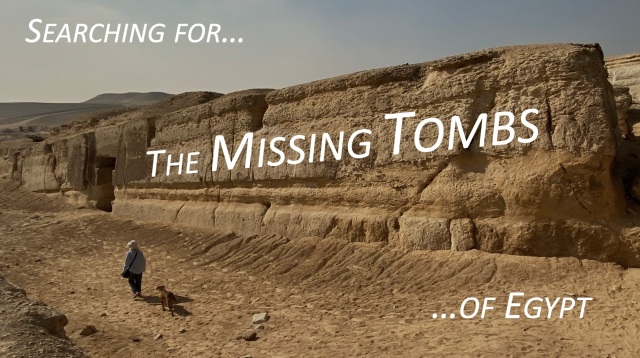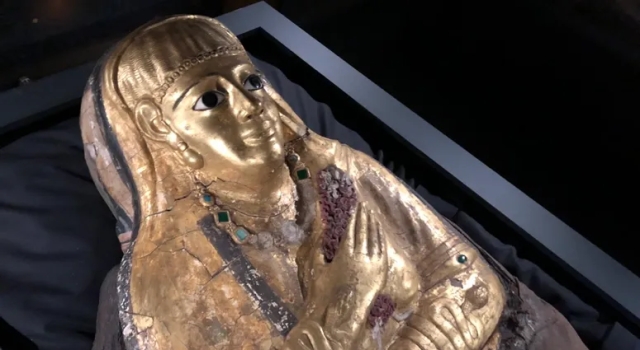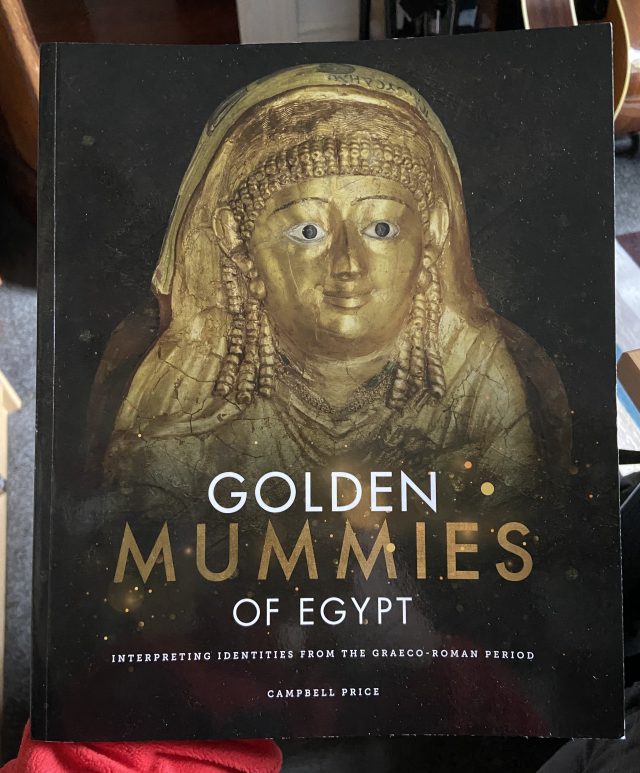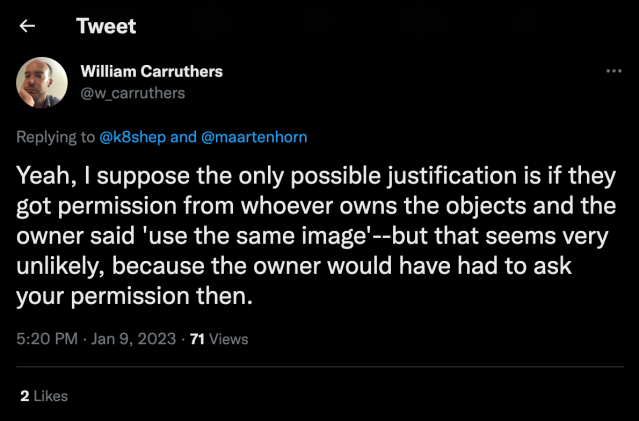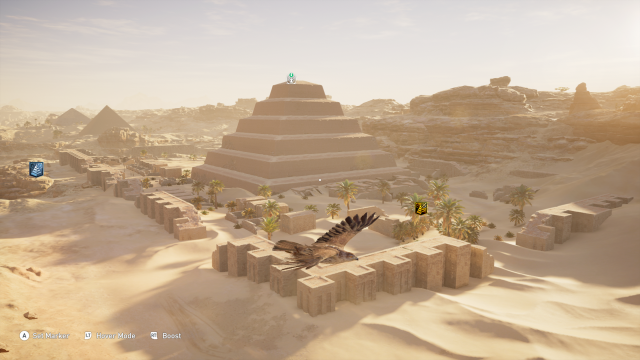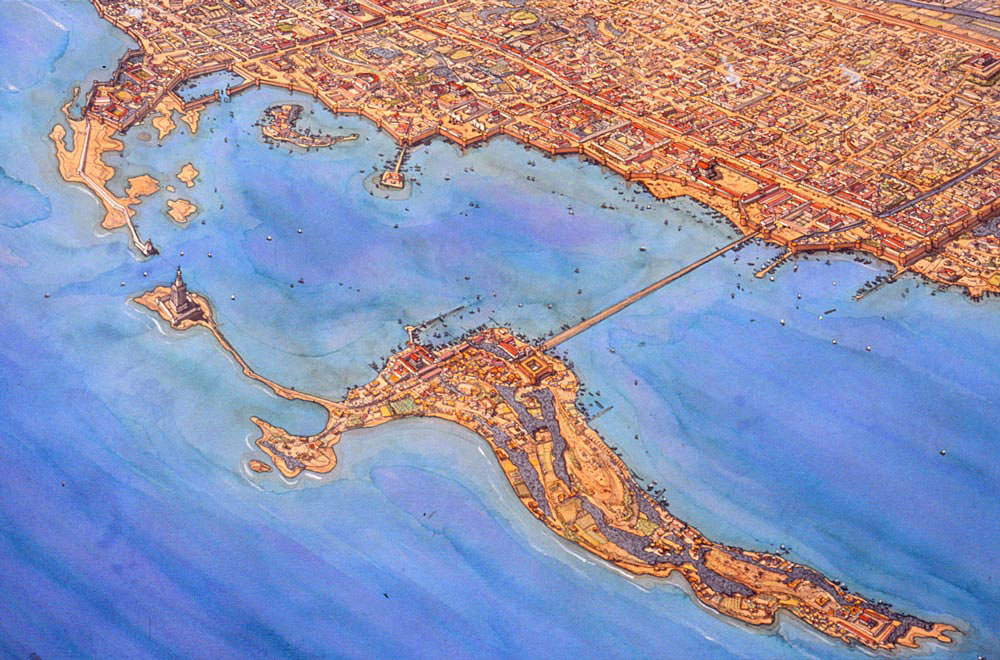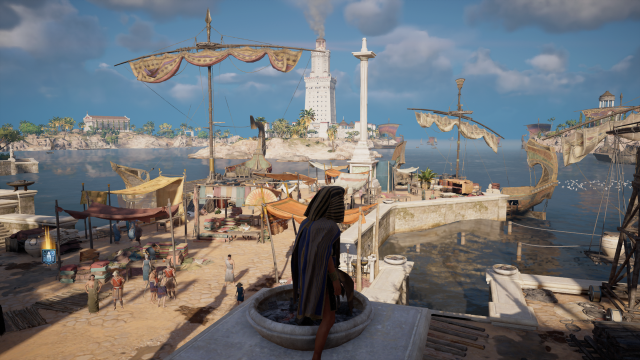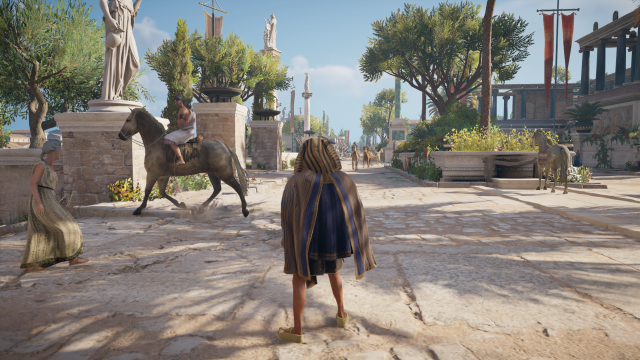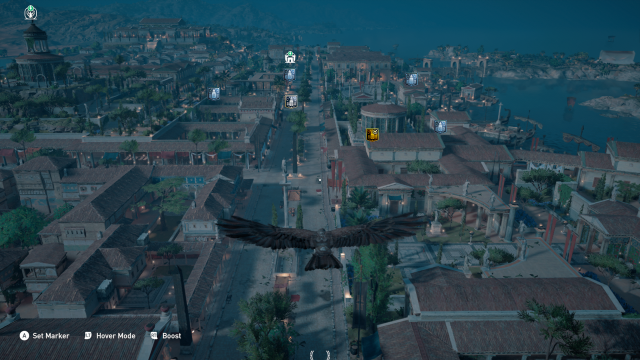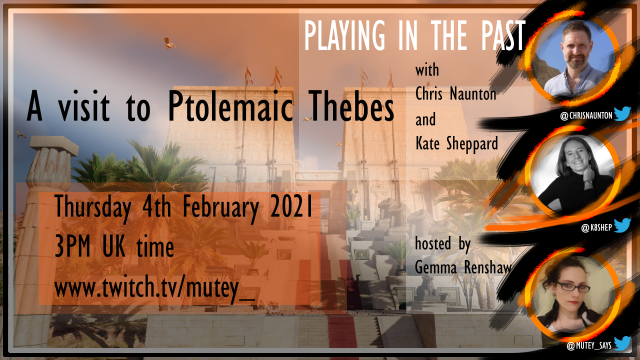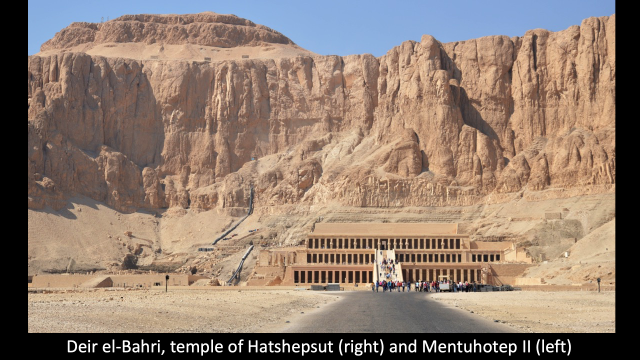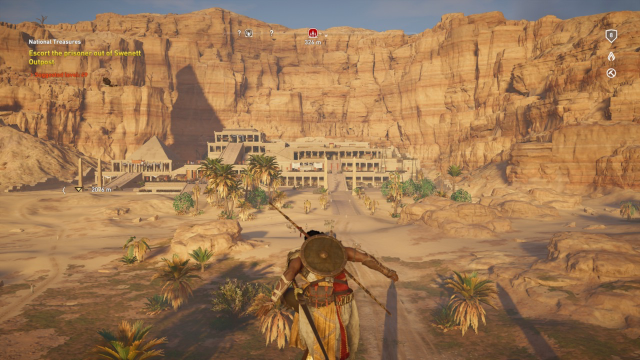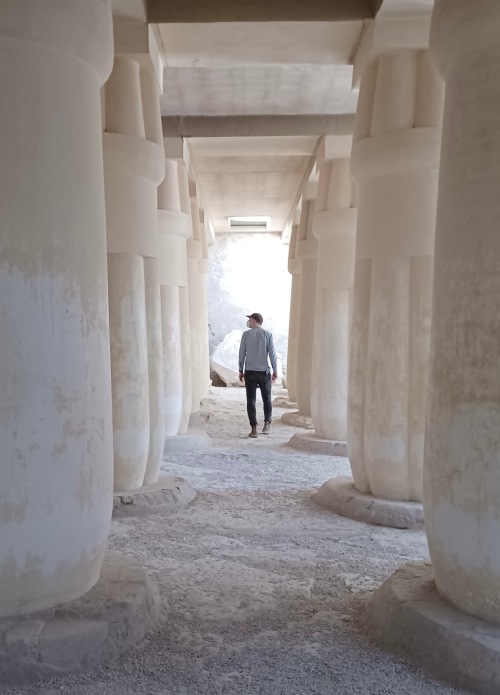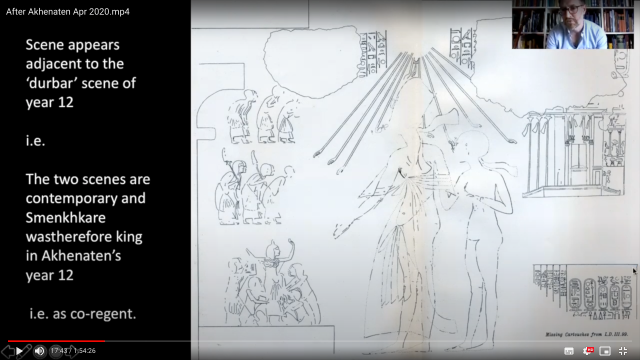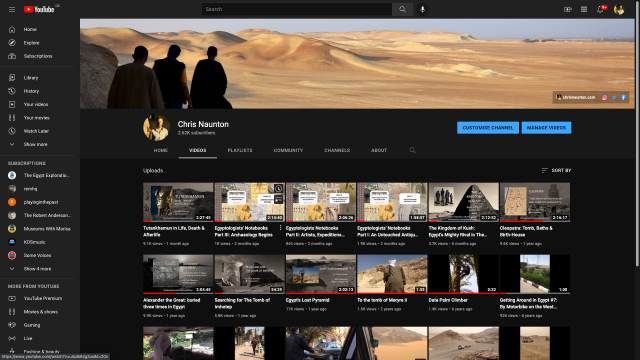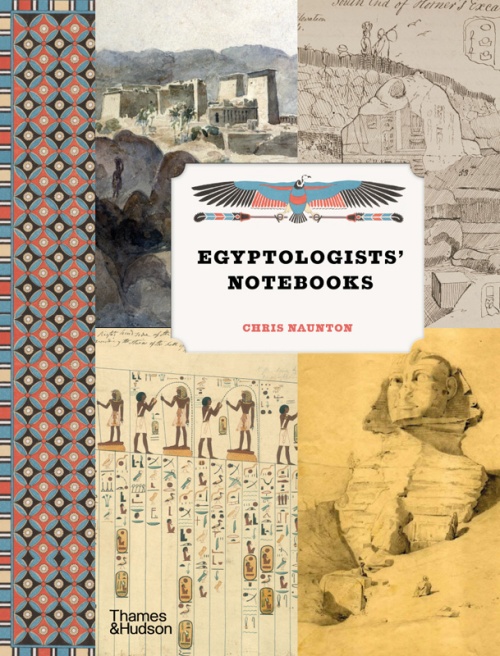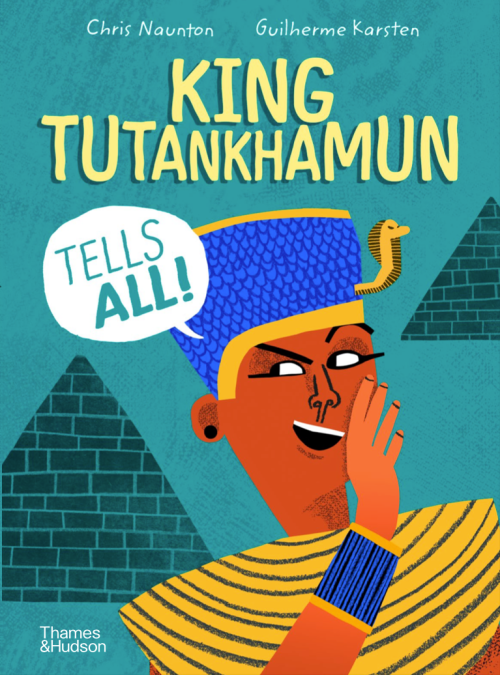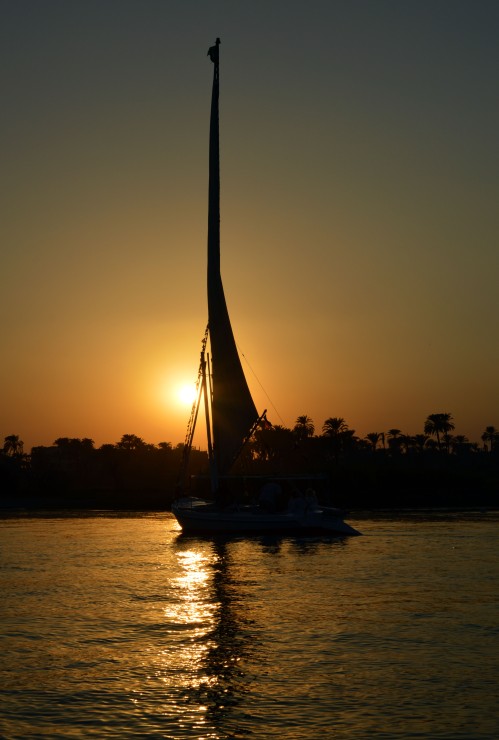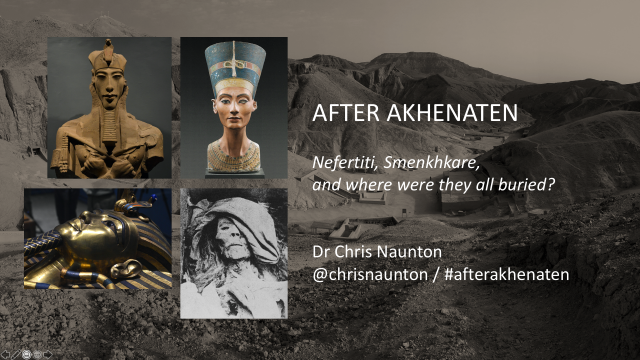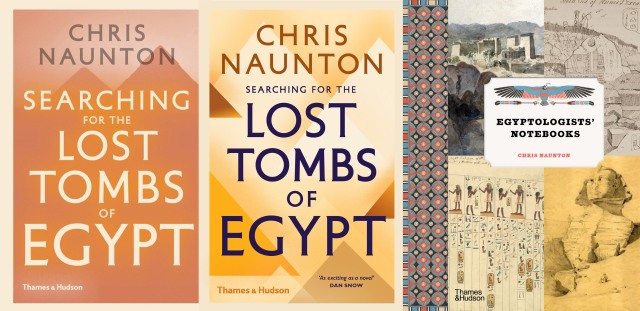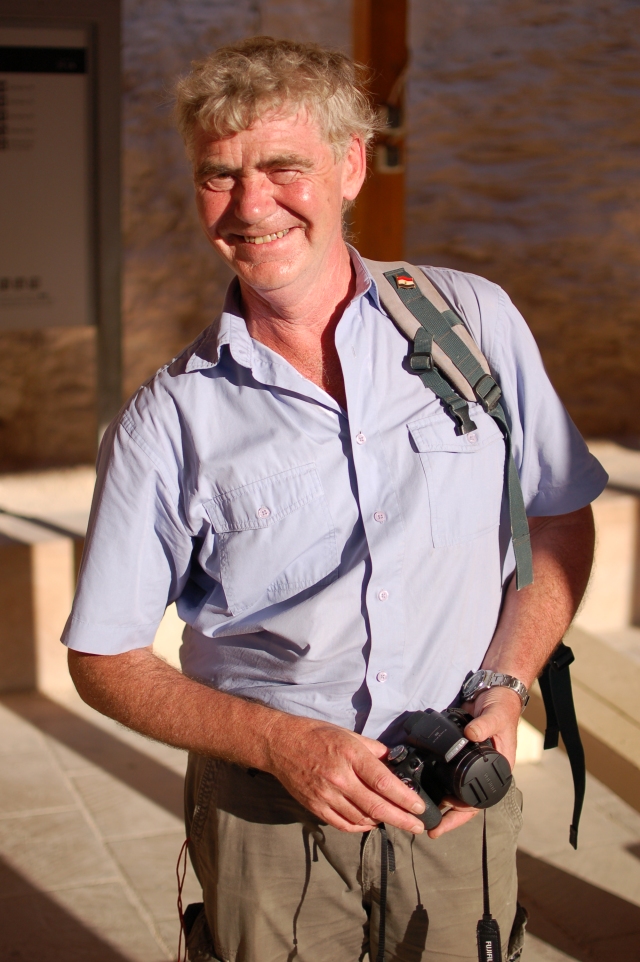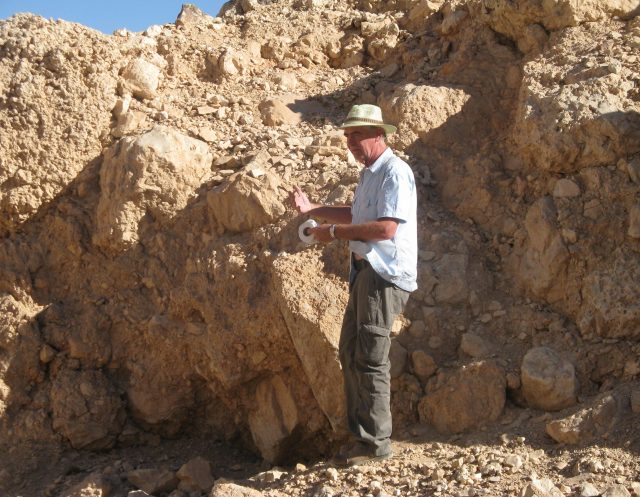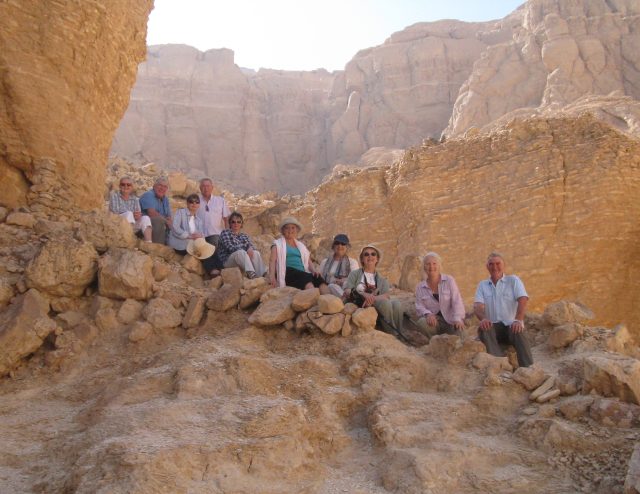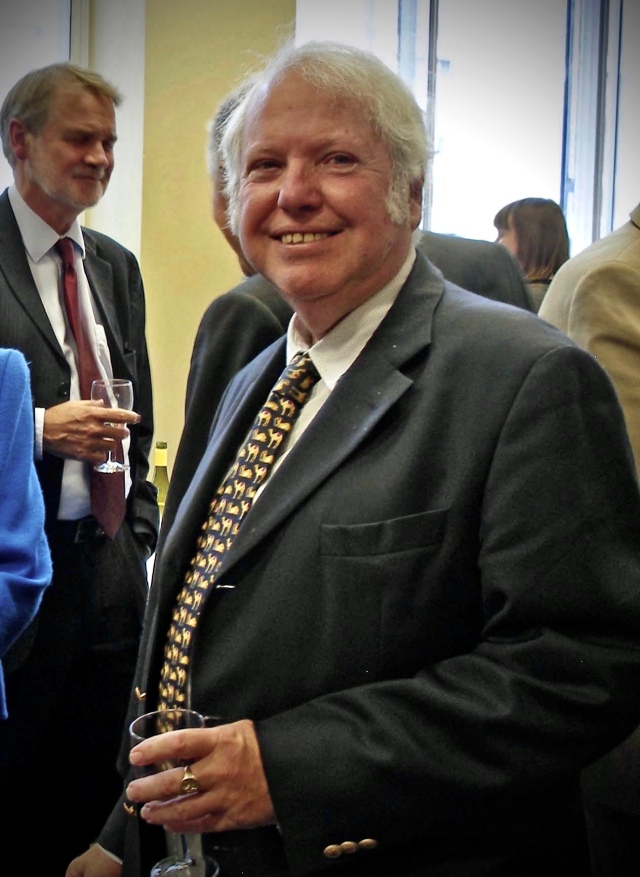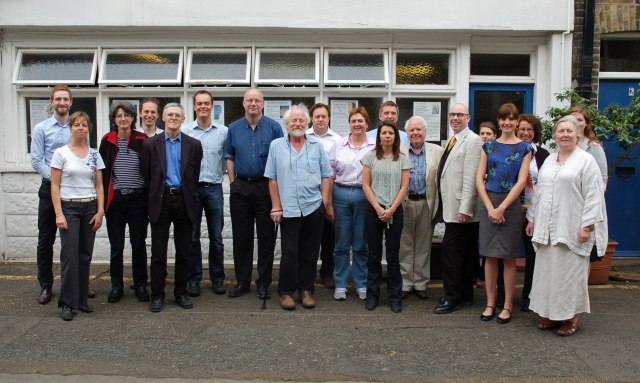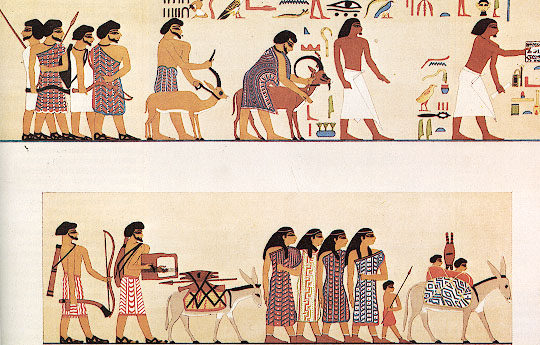I spent most of 2019 and a little bit of 2020 on the research and writing for Egyptologists’ Notebooks. In many cases this meant going through the papers of the thirty or so travellers, scholars and artists whose stories form the basis of the book, and more importantly the writings, sketches, maps and plans they made of sites and monuments in Egypt including some built by one of the greatest figures from the ancient world: Cleopatra.

Cleopatra and her son Caesarion, Temple of Hathor, Dendera
These archives included, for example, the papers of Robert Hay, James Burton, Edward William Lane, and Joseph Hekekyan which are kept in the British Library. The size of some of these collections is staggering. The Hay archive alone comprises approximately fifty folios, each of which might contain as many as 150 individual drawings. I quickly realised I was going to be seeing far more images than could ever be included in the book – agonisingly – and so began prioritising those that really stood out for some reason: many were just very beautiful or evocative, but the most interesting were the ones that showed a site or a view that has dramatically altered in the intervening years, or a monument that has since been moved or even disappeared completely…
In most instances I knew straight away what I was looking at. The artists were, naturally, drawn to the most striking sights, many of which are now famous as must-see places for visitors to Egypt: the pyramids of Giza, Karnak and Luxor temples, the colossi of Memnon, the Ramesseum, the Valley of Kings. These are places with which I’m very familiar of course, and had no trouble recognising in the drawings. In other cases I needed to look a little more closely to identify what I was looking at. The drawings weren’t always labelled and even when they were, the labels didn’t necessarily help. The names given to sites and monuments have changed over time; and while those we use today have, to some extent become standardised, that wasn’t the case to the same extent two centuries ago. With a bit of digging, however, I was usually able to establish what I was looking at. But in one or two instances I couldn’t, and one such monument, which appeared in more than one archive really caught my attention: the ‘Baths of Cleopatra’.
The ‘Baths of Cleopatra’
Before, I go any further, I should say now, for anyone getting too excited, that I never imagined that these ‘baths’ had anything to do with Cleopatra herself; it seemed much more likely that this was simply a colloquial name for a monument that was nonetheless probably ancient, and apparently quite spectacular.
The ‘baths’ were apparently somewhere in Alexandria and they appeared in drawings made by several of the individuals who appear in my book, including James Burton, Pascal Coste, and Hector Horeau. Burton and Coste had drawn plans of this monument, which appeared to comprise an elaborate series of chambers cut into the bedrock a short distance from the coastline, the largest incorporating a number of square-based pillars and opening, via a smaller, rectangular room, onto a circular chamber with smaller rooms, each identical in plan, leading off to the left, right and straight ahead. Large rock-cut monuments in Egypt are very often tombs and as I have an interest in the ‘lost tombs’ of Alexander the Great and Cleopatra – both of which were in Alexandria – I was keen to know more.
Burton and Coste’s plans differed slightly e.g. in the number and arrangement of pillars but were sufficiently similar in their main features – which seemed quite distinctive to me – for it to seem clear that they showed the same thing.

Burton’s drawing. © British Library Board, add ms 25634 f.4
Burton’s archive in fact included two versions of the same plan (add ms 25634 f.4 and f. 5), one – the more finished looking of the two – with the heading ‘EXCAVATION in the ROCK on the COAST of ALEXANDRIA’, both annotated with the phrase ‘(The) Catacombs Alexandria’. To this Burton had added the following note:
“Most of the rooms so full of sand that a man cannot stand upright in them
Square holes in the ceilings of several rooms through which the sand has accumulated
In several places the wall has been cut through
All about this part of the coast are remains of baths and catacombs
The whole has been plastered and probably painted from the remains of red lines in [illegible] places and in the room A the ceiling is divided by radiating lines and in the center there appears to have been a stucco [illegible]”
Coste’s added to his drawing this label:
“alexandrie 1819
Plan genèral du catacomb et du bains de cléopâtre”

Coste’s drawing of the ‘catacomb’ and ‘bains’ (‘baths’) of Cleopatra. From Pascal Coste Toutes les Égypte (Marseilles, Éditions Parenthèses / Bibliothèque Municipale de Marseille, 1998)
Horeau’s drawing is a view showing the interior of the monument and is simply labelled (on the mount) ‘Bain de Cléopâtre’. Horeau included two human figures for scale in his sketch which appears to show a large and impressive room with a pediment above a large doorway, leading into another room, which the drawing seems to show has a domed roof. The latter is presumably the circular room in Burton and Coste’s plans, and indeed Horeau’s drawing also seems to show further rooms leading off it.

Horeau’s painting which is labelled ‘Bain de Cléopâtre’. © Griffith Institute, University of Oxford. The image, and catalogue entry are available via the Griffith Institute website, here.
This looked like a very impressive monument, and yet it was clearly quite different from anything I knew of in Alexandria, and I had never even heard of these ‘baths’ before. So what was this monument, and what happened to it?
The Griffith Institute catalogue entry suggested that the site was “Alexandria. Kom el-Shuqafa. Underground tombs of the Graeco-Roman Period.” Although I was already beginning to think that ‘Baths of Cleopatra’ might well have been a name that had long since fallen out of use, and there were certainly catacombs at Kom es-Shoqafa, I had been to visit them on several occasions recently and was confident that these ‘baths’ were something different. The idea that my esteemed colleagues at the Griffith might have got this wrong only served to deepen the mystery.
E M Forster and the ‘baths’ in Scotland
Not knowing what they were, and with plenty of other wonderful material to use in my book, I tried not to get too distracted by this and put the question to one side.
Then in February this year, when I had almost completely finished my work on Notebooks and was taking a short holiday in Scotland, I visited the country’s largest second-hand bookshop, Leakey’s, in Inverness. If you like books, and the thrill of discovering lost treasures, this cavernous, converted church, brimming with piles of unsorted books, is the place to be. Suzanna, my fiancée, and I spent a couple of hours combing the seemingly endless shelves and could have stayed longer, but in fact I had made my great discovery within a few minutes’ of arriving. I saw a copy of E. M. Forster’s Alexandria: A History and Guide, and, to my delight, quickly found a reference in the index to the ‘Baths of Cleopatra’ and even a map showing where they were. This I had to have!

Mine was a copy of the third edition of Forster’s book, published in 1961, so apparently the ‘baths’ had survived and continued to be known by that name at least down to that time. His map would allow me to try to locate them in the modern maps and even satellite images provided by Google, to see if I could tell whether not there was anything left to see of them, and if it might even be possible to visit.
Forster had this to say (pp. 197-8):
“About quarter mile S. W. of Fort Ramleh, and close to a small modern pumping tower, are the so-called Baths of Cleopatra. She had nothing to do with them, but they are worth seeing. The western outer wall, of limestone blocks, is well preserved. Steps lead up through it. Within are pavements of pebble mosaic, fragments of stucco, a stone with a drain groove, &c. In a chamber to the left, is an oblong bath nearly six feet deep; steps lead down to it and in the centre of its pebbled floor is a little depression; in the edge of the brim and on the wall opposite are niches, as if to support beams, and provision for the entrance and exit of the water can also be seen. Further on, past a small stucco cistern, is an entrance to a small room which contains an oblong bath to lie down in, quite modern and suburban in appearance; close to it, under a niche, is a footbath – the bather sat on a seat which has disappeared but whose supports can be seen. – These baths are all in the western part of the enclosure; the rest contains other and larger chambers but is in worse preservation. It is much to be wished that these baths, which have recently been excavated, could be protected properly; otherwise they will share the fate of the other antiquities within the military zone.1
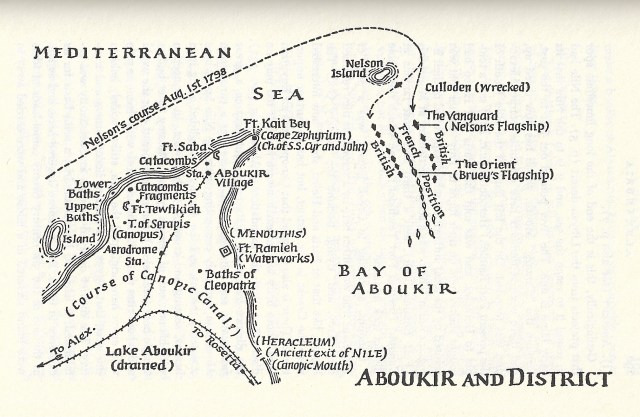
Forster’s map of ‘Aboukir and District’ with the ‘Baths of Cleopatra’ shown a little way inland. After Forster, E. M. Alexandria: A History and Guide (Gloucester, Mass., Peter Smith, 1968), 189.
So, apparently, the ‘baths’ were to be found a little outside Alexandria itself, around 20km along the coast around the western edge of the Bay of Aboukir. This was a surprise, as everything I had seen up to this point suggested the ‘baths’ were in Alexandria proper. I supposed that for Burton, Coste et al, they might nonetheless have considered this to have been the general area of Alexandria. And it would help to explain perhaps why I had never come across the ‘baths’ before – they were beyond the limits of the city, to which most visitors like me would confine themselves, and moreover, according to Forster, they lay in what was, by his time, a military zone. It’s a shame that Forster included no plan of the ‘baths’; his description made no mention of the circular room with a domed roof, but nothing he had written made me think he had not visited the very same monument drawn by Burton, Coste and Horeau. Perhaps the circular room and/or its dome had fallen into ruin and were no longer visible? As Forster wrote, “the rest contains other and larger chambers but is in worse preservation.”
Significantly, perhaps, Forster’s map seems to place the ‘baths’ a little way inland from the coast itself, apparently in keeping with Burton and Coste’s plans which show the greater part of the monument lying just inland from the shore.
At this point, I decided to ask a friend, Dr Daniele Salvoldi, who knows Alexandria very well, if he knew of the ‘baths’ and whether or not it would be possible to go and see them. This turned out to be a very long and productive exchange, and eventually led to the solution to the mystery. But before I reveal what that was…
Daniele knew of the ‘baths’ and had tried to locate them on a modern map, placing them in the area of the Ramleh Fort, in keeping with Forster’s description. One of his first thoughts was that there would be no way we could go and see them because of the military presence in the area.
He also pointed me to an article on the fortresses in the Aboukir area, which mentions the ‘baths’ as part of a description of El Tawfekeya Fort:
“It was once known by “El Shaheeneya” Fort. The fort … is currently used as Military Area and this is the reason that it’s not listed as a monument yet. It lies in the western part of Abu Qir, it is located on fortified hill very near to canope Remains (Cleopatra baths) & Omar Toson Island inside a military site. It was constructed in the period of Ismail pasha & was completed by Tawfeek pasha in the same style of Mohamed Ali’s forts.”2
The article describes how the area became the focus of the construction of coastal defensive buildings during the reign of Mohamed Aly (ruler of Egypt c. 1805-1848) – twenty-five fortresses had been built in the area by the end of his life – and notes that although these buildings are now of historical importance they are relatively little known and inaccessible due to the area retaining its military importance. It seemed to me that this might well help to explain the relative obscurity of the ‘baths’ today, despite their apparent grandeur and having been an important part of the itinerary for visitors in the early Nineteenth Century, and it struck me that the phenomenon of archaeological remains and historic buildings disappearing from view, creating a kind of archaeological ‘blind-spot’, due to the military concerns taking priority, is an interesting phenomenon in itself. In any case, it seems this would prevent me from making any investigations of my own on the ground, which would certainly have been in the planning for my next trip to Alexandria otherwise.
Misled by E. M. Forster
But then I got another message from Daniele with some surprising news.
He had been checking a copy of Monumental Tombs of Ancient Alexandria. The Theatre of the Dead (Cambridge University Press, 2002) by Marjorie Venit, and came across the plan of a tomb complex that appeared to match the ‘baths’ more or less exactly. According to this, what Burton, Coste and others had seen was a monumental tomb-complex now known as the ‘Grand Catacomb’ in the Wardian district of Alexandria (sometimes also known as ‘Mex’). Daniele kindly sent me some snapshots of the relevant pages and it was clear he was right. But this was confusing, because Wardian is a long way – around 25km – from Aboukir, on the coast in the area of the old port.
‘What?’ I was left wondering… Had I misunderstood: are the ‘baths’ and the catacombs different things? Maybe I have… Burton’s drawing makes no mention of any baths… And in fact Coste’s drawing is labelled ‘Plan genèral du catacomb et du bains de cléopâtre’ – ‘general plan of the catacombs and the baths of Cleopatra’ (my emphasis), but at the same time his map seemed to show them as being right next to one another. And Horeau’s drawing – labelled ‘Bain de Cléopâtre’ – seemed clearly to show the catacombs. So, it seemed there were both catacombs and baths in Wardian, separate from one another, but close enough to have become confused, at least by Horeau, and others (see below). And as for the ‘baths’ that were known to Forster and to the authors of the article on the Aboukir forts, these must have been something different entirely. In other words the name ‘baths of Cleopatra’ had, it seemed, been attached to at least two different sites. It’s not difficult to imagine the famous queen’s name being associated with various sites and monuments in Alexandria, and given she is celebrated for bathing (albeit in milk), it should be no surprise that certain places associated with such an activity would come to take her name. There were plenty of such places in Alexandria it seems, and there are even baths in Turkey that go by a similar name: ‘Cleopatra’s Bath’.
Necropolis and the Grand Catacomb
In any case though, the spectacular monument that Burton, Coste and Horeau had visited in the first half of the 19th century was indeed the Grand Catacomb at Wardian.
This was a part of the ‘Necropolis’ area of Alexandria, as described by Strabo (writing shortly after the end of the Ptolemaic Period which ended with the defeat of Mark Antony and Cleopatra by Octavian – Augustus Caesar – and the absorption of Egypt into the Roman Empire):
“Next, after the Heptastadium, one comes to the Harbour of Eunostus, and, above this, to the artificial harbour, which is also called Cibotus; it too has ship-houses. Farther in there is a navigable canal, which extends to Lake Mareotis. Now outside the canal there is still left only a small part of the city; and then one comes to the suburb Necropolis, in which are many gardens and groves and halting-places fitted up for the embalming of corpses”3
This is the area in which the spectacular discovery of the Gabbari necropolis was made in the 1990s during the construction of a road. The site was excavated by the Centre d’Études Alexandrines, led by Jean-Yves Empereur, and after just two seasons of rescue excavation had cleared forty-three collective tombs of the Hellenistic style, the largest containing 250 loculi, niches designed to house the remains of the deceased some of whom were cremated in the Macedonian tradition while others were mummified, as Egyptian custom required. These were tombs for the middle classes and were used over and over for generations; the excavators sometimes found the remains of as many twelve individuals in a single loculus, older remains simply being moved aside to make room for each new entrant.
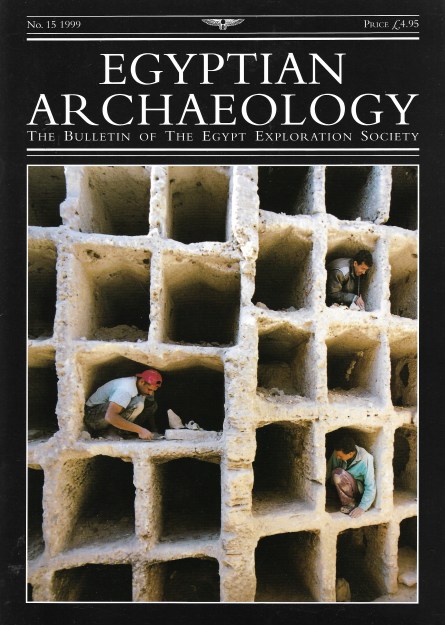
Front cover of issue 15 of the Egyptian Archaeology: The Bulletin of the Egypt Exploration Society (1999) showing the loculi at Gabbari during the rescue excavations.
The ‘Grand Catacomb’ seems to have been built, or rather cut out of the living rock, for one or more individuals of higher status. The main axis of the tomb leads the visitor from a peristyle (i.e. surrounded with columns) court into the circular room with a domed rood from which leads to three triclinia – rooms with benches on three sides on which people would recline while dining – each containing undecorated sarcophagi. The discovery of a mosaic floor on the surface suggests there may at one point have been a funerary chapel above the hypogeum (underground part of the tomb). According to Venit, the prevailing view is that tomb should be dated to the Roman Period, probably the first two centuries CE (too late to be anything to do with Cleopatra!).
Venit’s brief notes on the tomb are based on the information published by Achille Adriani, the third of three great Italian archaeologists to hold the post of Keeper of the Graeco-Roman Museum at Alexandria – and by extension, archaeologist-in-chief in the city – following Giuseppe Botti and Evaristo Breccia. Adriani excavated the ‘Grand Catacomb’ in 1952 and was, according to Venit, ‘the only modern scholar in the first half of the twentieth century who actually saw the tomb’.4
Lost now, or found?
This last part, in particular, intrigued me. If Adriani was the only one to have seen the tomb in the first half of the 20th century, why was this, when it had apparently been so visible to travellers in earlier times? Perhaps it had been damaged, or surrounded by more modern buildings to the extent that visiting became far less appealing, and it lost some of its allure. In any case, more to the point, had anyone seen it since Adriani? Venit, whose book was published in 2002, says it is “Extant: partially preserved; at the north end of Bergouin Street among the lumber storehouses (fenced).”5
Could it still be there even now? Looking at the satellite view in Google Maps it was clear that the area had become heavily industrialised. Just inland from the Eunostos Harbour / Old Port where the tomb should have been I could see container ships, a canal, the circular buildings of industrial refineries, large dusty open spaces, a grid of streets with residential(?) buildings built very close to one another in between. Along the shore where I thought I might have found the ‘baths’ themselves, I could see only modern industrial buildings, and some vague outlines beneath the surface of the ocean that could have been anything. Could the catacomb have survived? It seemed unlikely.
I’d been gathering material for this piece for a few months, returning to it every now and again and found myself caught up in staring at the satellite images again not long ago. This time I looked again at Venit’s map first. She placed the ‘Grand Catacomb’ at one end of the middle of three distinctive diagonal shapes. I had no idea what these might be but decided to see if I could see any similar shapes in the satellite view and to my amazement I could. I zoomed in, and at the end of one of them, surrounded on one side by a busy road and on the others by a dusty area filled with cars and lorries, I could see what looked like a fenced area, apparently unencumbered by any buildings or vehicles, and exhibiting signs even of some vegetation, as if it was protected. Could this be it? I think it is. Is there anything really to see from the ground? I’ll have to wait till I can next get to Alexandria.
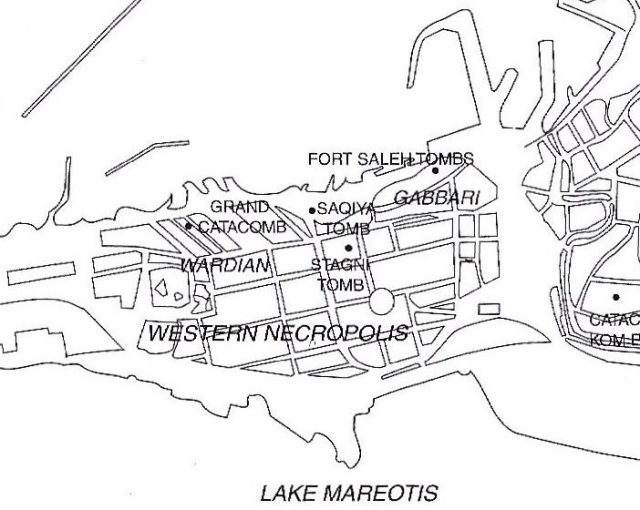
Map of the Necropolis area in modern times, showing the coastline and location of ‘Grand Catacomb’ in the Wardian district. After Venit, Monumental Tombs of Ancient Alexandria. The Theatre of the Dead (Cambridge University Press, 2002), fig. I, p. 2.

Satellite image from Google Earth showing the same part of Alexandria, with the probable location of the Grand Catacomb marked with a red pin.
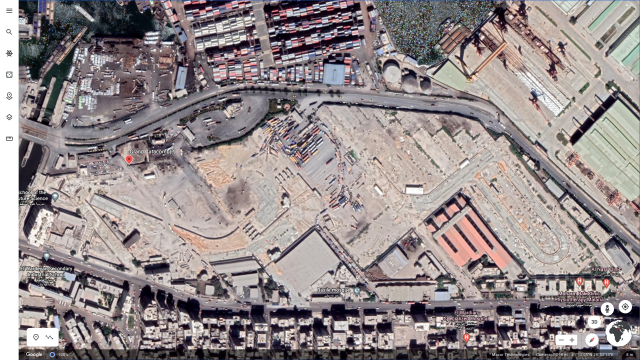
The same location zoomed in a little…

…and a little bit more…
In the meantime, I was still dying to know what if anything could still be seen of this monument. I had seen no image of it made later than the 19th century and not a single photograph. The major publication of the tomb appeared to be Adriani’s Repertorio d’Arte dell’Egitto Greco-Romano Series C (Rome, 1966) but this was not a volume I was familiar with; there was no copy in the EES library, visiting the British library was proving very difficult owing to the COVID-related restrictions and second-hand copies were few and far between, and expensive. But, dying to see if the tomb was illustrated inside, and sensing that such a rare but important book would be a valuable addition to my library (an occupational hazard) I cycled over to a second hand bookshop in Finchley which appeared to have the only copy available for sale in the UK. And of course I bought it. I was very pleased to find that it includes a number of photographs of the interior of the Grand Catacomb, one of which I have taken the liberty of including here.
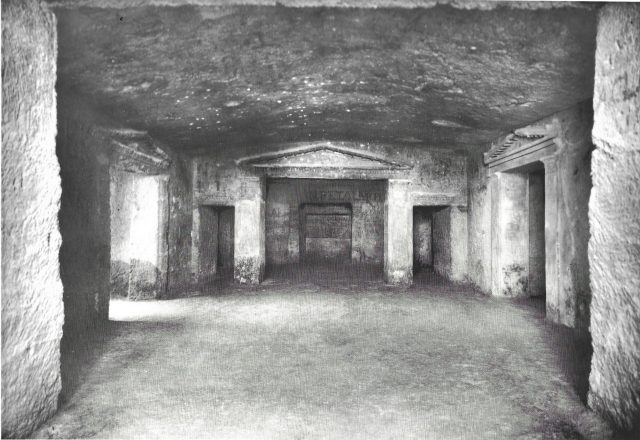
A view along the central axis of the Grand Catacomb following restoration, with the circular, domed room beyond the monumental doorway directly in front of the viewer. After Adriani, Repertorio d’Arte dell’Egitto Greco-Romano Series C (Rome, 1966), pl. 91.
I have subsequently gathered a number of other historic descriptions and images of the tomb – see the appendix below.
So what? (concluding remarks)
So what do we learn from all this? Maybe not that much. There’s nothing that’s really new to scholarship; Professor Venit and others familiar with the Grand Catacomb would have been able to tell me straight away what Burton’s drawing shows. And yet, her bibliography suggests she was unaware of that particular drawing, and perhaps also those of Coste and Horeau, so perhaps that’s something. And if the Griffith Institute can make a mistake about what and where the ‘Baths of Cleopatra’ were then at least I know I’m not alone in my confusion.
I think there are a few wider points worth making too.
Confusion over the name. First, there’s the conflation of the baths i.e. the rock cut pools at the edge of the ocean, and the tomb complex, both in the Wardian district, which, together, were commonly and repeatedly referred to as the ‘Baths of Cleopatra’ in nineteenth century drawings and literature. Second, there’s the fact that the name ‘Baths of Cleopatra’ seems to have been used subsequently, in the 20th century, to refer to a different place, in Aboukir. Third, while the Wardian site was referred to as the ‘Baths of Cleopatra’ in the 19th Century, in modern literature the tomb complex is referred to as the ‘Grand Catacomb’ only – Venit makes no mention of the name ‘baths’ at all. This shouldn’t be so surprising as many sites are now given different names to those used two centuries ago – Belzoni believed he had discovered the ‘tomb of Psammuthis’ and not that of Sety I; the tomb of Ramesses III, also in the Valley of Kings, was known to many as the ‘Harper’s Tomb’ or ‘Bruce’s Tomb’ until the hieroglyphs decorating it could be read and the original owner identified. The temple known to many early visitors as the ‘Memnonium’ is nothing to do with legendary Memnon, king of the Aethiopians, but rather a temple of Ramesses II which we now call ‘The Ramesseum’. Memnon’s name still sticks to the famous Colossi however, even though we know the statues really represent Amenhotep III.
Disappearance of the site. By contrast with, for example, the famous Theban monuments which still (COVID-19 notwithstanding) attract thousands of visitors every year, the ‘Grand Catacomb’ seems to have disappeared from view almost entirely. For this reason, knowledge and memory of it has been lost almost entirely, and exists only in the pages of one or two obscure publications, and in the minds of a handful (I suspect) of specialists.
It seems very likely that there would not have been so much confusion had the ‘Baths’ been more visible over the years – they would have been visited, documented, and would have become more familiar.
I’m yet to have the opportunity to see whether anything can still be seen on the ground (I’ll let you know when I get a chance), but even the two Ministry of Antiquities inspectors I contacted in Alexandria were unable to tell me what or where this obscure but evidently spectacular monument was.
For a long time I have felt as though Alexandria has been somehow out of reach, a blindspot, for me at least. I only went myself for the first time in 2015 by which time I had been to Egypt dozens of times over almost twenty years and indeed it seems many frequent visitors to Egypt rarely go or are yet to make the trip. Why? Is it because its archaeological sites are perhaps not as spectacular as elsewhere? Or is it, moreover, that they relate to a period of Egyptian history that somehow doesn’t pique the interest of so many? Too Hellenistic / Roman, or late to be as appealing as the New Kingdom monuments in Luxor perhaps. I was delighted to read this passage in Venit’s book which articulates the thought far better than I could and shows that I wasn’t the only one to have had it:
“three major reasons conspire to keep Alexandrian monumental tombs almost entirely unknown beyond the few scholars who excavate in Alexandria or those who take particular interest in its monuments. First, now, as in the nineteenth century, Egyptian archaeology primarily focusses on the splendor of Egypt’s more easily visible and more exotic pharaonic past. Second, most tourists and the great majority of scholars arriving by air directly in Cairo find it even more convenient to avoid the city than did their nineteenth-century sea-dependent counterparts. Third, despite recent archaeological activity, the greatest number of Alexandrian tombs were excavated before World War II and, aside from the tombs at Chatby published by Breccia, those at Kom el-Shoqafa that comprise Schreiber’s monumental work, and those excavated in the 1930s at Moustapha Pasha published by Adriani, they exist only in difficult-to-access preliminary reports.”6
Venit herself, clearly felt that monuments such as the Grand Catacomb were in danger of being lost, stating that one of the purposes of her book was:
“to preserve precious monuments that can no longer speak for themselves. Despite relatively few remaining tombs, most exist only in the pages of mouldering journals and antiquarian tomes, the greatest number of which are published in Alexandria and the others in Europe during the past century and a half. Few libraries in the United States own any of these volumes, and none owns all of them. Crucial volumes are not held in any library. For this reason, description that might otherwise be considered superfluous may be given at detailed length because, aside from the fact that many of the tombs are lost, the volumes in which they were published during the last half of the nineteenth century and the first half of the twentieth may very soon have joined them in demise.”7
What’s interesting, to me at least, is that what was clearly a very interesting and apparently spectacular monument, visited by the kind of people who were trying to make comprehensive records of the country’s monuments, have disappeared from view, not only physically, but also from the records, and from memory (is that important?)?
Venit’s reference to the obscurity of the literature shows that even when things are published something else is required for knowledge of them to be maintained. People need to have access to those books, to read them, to discuss them in their own writing and conversations.
We tend to assume that ancient sites and monuments became lost in the distant past and are then revealed by archaeologists in more modern times, and that those that survived since antiquity will now survive for good. The story of the ‘baths’ show how easily such things can be lost again.
NOTES:
1. Extract from Forster, E. M. Alexandria: A History and Guide (Gloucester, Mass., Peter Smith, 1968), 197-8.
2. Shahira Sharaf Eldin, Fatima Fekry, and Adel El Menchawy, ‘Abu Qir fortresses as vital assets for tourism motivation and community development’ Journal of Heritage Conservation 34 (2013), 48. Accessed online (here) April 2020.
3. Strabo. Geography, Volume VIII: Book 17. General Index. Translated by Horace Leonard Jones. Loeb Classical Library 267. Cambridge, MA: Harvard University Press, 1932. Pp. 39-41. Reproduced here.
4. Venit, M. S. Monumental Tombs of Ancient Alexandria, 132
5. Venit, M. S. Monumental Tombs of Ancient Alexandria, 198
6. Venit, M. S. Monumental Tombs of Ancient Alexandria, 5.
7. Venit, M. S. Monumental Tombs of Ancient Alexandria, 5-6.
ACKNOWLEDGEMENTS:
Big thank yous to Dr Daniele Salvoldi for solving the problem and showing me what the ‘baths’ really were; to Dr Kate Sheppard for pointing me in the direction of the Kellogg, Gardner Wilkinson and Baedecker sources below; and to Dr Chris Elliott for directing me to Mayer’s drawings and to several other sources. Also to the British Library and Griffith Institute, Oxford for permission to reproduce the Burton and Horeau drawings respectively. Thank you all!
APPENDIX:
Historical Sources for the ‘Baths of Cleopatra’ or ‘Grand Catacomb’ of Wardian.
The following is by no means an exhaustive list of sources but these seem to be among the most interesting. Authors who feature in Egyptologists’ Notebooks are marked with an asterisk.*
Richard Dalton (1715-1791)
Antiquities and Views and Greece and Egypt (London, 1751-1752).
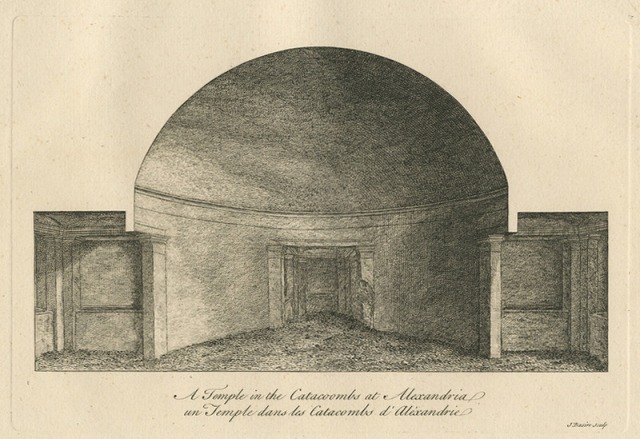
‘A Temple in the Catacombs at Alexandria’. Accessed online (here) December 2020.

‘Plan of the Temple in the Catacombs at Alexandria’. Accessed online (here) December 2020.
Frederik Ludwig Norden (1708–1742)*
Travels in Egypt and Nubia (London, Printed for Lockyer Davis and Charles Reymers, 1757), pp. p. 21-2. Accessed online (here) December 2020.
“The sepulchral grots begin from the place, where the ruins of the old city terminate, and they run to a great distance along the border of the sea. They are all dug in the rock-, sometimes one over another, sometimes one aside of another, according as the situation of the ground has permitted. Avarice, or the hope of finding something there, has caused them all to be opened. I have net feen a single one shut up ; and have absolutely found nothing within them. It is easy to judge, by their shape, and by their great number, of the use, for which they were designed. We may fay, that in general they have only a sufficient breadth to contain two dead bodies, one lying by another. Their length exceeds but very little that of a man, and they have more or less height, according to the disposition of the rock. The greatest part have been opened by violence; and that which remains of them intire is not ornamented either with sculpture or painting.”
Voyage d’Égypte et de Nubie Volume 1 (Paris, Pierre Didot l’ainé, 1795), pl. XIII. Accessed online (here) December 2020.

Richard Pococke (1704–1765)*
A Description of the East and Some Other Countries: Volume 1 (London, Printed for the author by W. Bowyer, 1745), p. 9. Accessed online (here) December 2020.
“To the west, beyond the canal of Canopus, and near a Sheik’s burial place, are some Catacombs ; they consist of several apartments cut in the rock , on each side of an open gallery: On both sides of these apartments are three stories of holes, big enough to deposite the bodies in. Here we may suppose the suburbs began, in which were gardens, sepulchres, and places to prepare the bodies for interment; as the quarter call’d Necropolis, or city of the dead, was to the west of the city. The Catacombs extended above a mile to the west, and there are a great number all along by the sea; many of them have been wash’d away by the water, which in such a long tract of time has gain’d on the freestone rock, as appears by the remains of them seen in the sea. I was in some grottos cut out of the rock, in long narrow galleries running parallel to one another, and some also crossing them at right angles. These I conjectured were those magazines in which they embalmed the bodies. The most extraordinary Catacombs are towards the further end, and may be reckon’d among the finest that have been discover’d; being beautiful rooms cut out of a rock, and niches in many of them, so as to deposite the bodies in, adorn’d with a sort of Doric pilasters on each side. The round room, and that leading to it are very beautiful, and so are the four rooms drawn in the plan with niches.”

Luigi Mayer (1755–1803)
Views in Egypt, from the original drawings in the possession of Sir Robert Ainslie, taken during his embassy to Constantinople (London, Printed by Thomas Bensley, for R. Bowyer, 1801), 26-7. Accessed online (here) December 2020.

“The catacombs of Alexandria, of which we have given a representation, are on the south of the old port, their present entrance being a small irregular hole, a few paces from the edge of a basin, that communicates with it. This hole is so narrow, that you are obliged to creep in feet foremost. Having passed it, you find yourself in a chamber of moderate size, but so filled with earth, that a man can hardly stand upright in it. Three sides of this chamber have each another cut out of it only eight feet square, and in three sides of each of these are square recesses, the fronts of which are ornamented with a kind of Tuscan pilasters, supporting a segment of an arch. From the first chamber you pass into various others. One is a parallelogram, about fifteen feet wide, the ceiling of which is a very flat segment of an arch; and at the farther end of it are two Tuscan pilasters, supporting an architrave, cornice and pediment, forming a large door, on each side of which is a small door, on each side of which is a small door ornamented in the same manner, only without the pediment. These three doors lead into a circular chamber of the same width, its roof a very flat dome resting on an architrave; and from this chamber you enter three smaller square chambers, with three recesses in each, exactly as in the first chamber. All these chambers are cut out of the solid rock, very neatly worked, stuccoed over. Some of them had square openings in the roof, to admit light, but these are now stopped up. They are all extremely dry, and similar in style; but how far they extend is impossible to say, they are now so filled, and the original entrance to them is now equally unknown.”
Mayer was clear that that and ‘baths’ were separate from the ‘catacombs’, his descriptions and drawings appearing separately from one another in his published account:
p. 33. Accessed online (here) December 2020.
“THE BATH OF CLEOPATRA As it is vulgarly called, is a large basin, a little to the west of the old port, on one side of which are three small square rooms, hollowed out of the solid rock.”
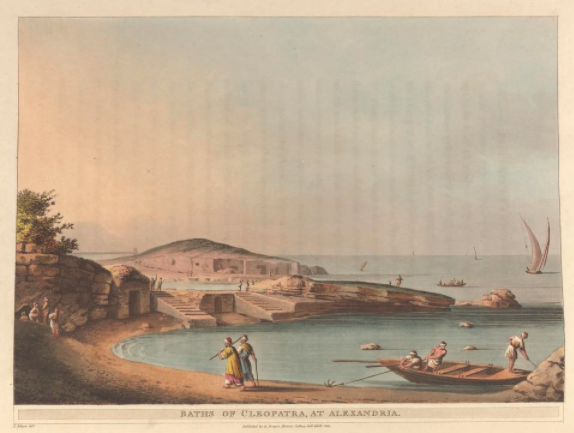
Description de l’Égypte. 2nd Ed. Antiquities, Volume V (Plates) (1823), pl. 42. Accessed online (here) December 2020.

Edward Daniel Clarke (1769-1822)
Travels in various countries of Europe Asia and Africa. Part the Second Greece Egypt and the Holy Land (London, R. Watts for Cadell and Davies, 1813), 286-9. Accessed online (here) December 2020.
“The Alexandrian guides to the Catacombs will not be persuaded to enter them without using the precaution of a clue of thread, in order to secure their retreat. We were therefore provided with a ball of twine to answer this purpose; and also with a quantity of wax tapers, to light us in our passage through these dark chambers. They are situated about half a league along the shore, to the westward of the present city. The whole coast exhibits the remains of other sepulchres, that have been violated, and are now in ruins. The name of Cleopatra’s Bath has been given to an artificial reservoir, into which the sea has now access; but for what reason it has been so called, cannot be ascertained: it is a bason hewn out of the rock ; and if it ever was intended for a bath, it was, in all probability, a place where they washed the bodies of the dead before they were embalmed. Shaw maintained that the Crypt a of Necropolis were not intended for the reception of mummies, or embalmed bodies; in which he is decidedly contradicted by the text of Strabo. Perhaps he was one of those who had been induced to adopt an erroneous opinion that mummies were placed upright upon their feet in Egyptian sepulchres, and therefore was at a loss to reconcile the horizontal position of the Thecce with his preconceived notions. We shall presently have very satisfactory evidence as to the manner in which embalmed bodies were laid, when deposited within these tombs by the inhabitants of Egypt, before the foundation of Alexandria. The original entrance to them is now closed, and it is externally concealed from observation. The only place whereby admittance to the interior is practicable, may be found facing the sea, near an angle towards the north: it is a small aperture, made through the soft and sandy rock, either by burrowing animals, or by men for the purpose of ransacking the cemetery. This aperture is barely large enough to admit a person upon his hands and knees. Here it is not unusual to encounter jackals, escaping from the interior, when alarmed by any person approaching: on this account the guides recommend the practice of discharging a gun, or pistol, to prevent any sally of this kind. Having passed this aperture with lighted tapers, we arrived, by a gradual descent, in a square chamber, almost filled with earth: to the right and left of this are smaller apartments, chiseled in the rock: each of these contains on either side of it, except that of the entrance, a Soros for the reception of a mummy; but owing to the accumulation of sand in all of them, this part of the Catacombs cannot be examined without great difficulty. Leaving the first chamber, we found a second of still larger dimensions, having four Crypta with Soroi, two on either side, and a fifth at its extremity towards the south-east. From hence, penetrating towards the west, we passed through another forced aperture, which conducted us into a square chamber without any receptacles for dead bodies; thence, pursuing a south-western course, we persevered in effecting a passage, over heaps of sand, from one chamber to another, admiring everywhere the same extraordinary effects of labour and ingenuity, until we found ourselves bewildered with so many passages, that our clue of thread became of more importance than we at first believed it would prove to be. At last we reached the stately antechamber of the principal sepulchre, which had every appearance of being intended for a regal repository. It was of a circular form, surmounted by a beautiful dome, hewn out of the rock, with exquisite perfection, and the purest simplicity of workmanship. In a few of the chambers we observed pilasters, resembling, in their style of architecture, the Doric, with architraves, as in some of the most antient sepulchres near Jerusalem; but they were all integral parts of the solid rock. The dome covering the circular chamber was without ornament; the entrance to it being from the north-west. Opposite to this entrance was chap, vii. a handsome square Crypt with three Soroi; and to the right and left were other Cryptae, similarly surrounded with places for the dead.”

Image via Wikimedia Commons (here).
Miner Kilbourne Kellogg (1814-1889)
Kellogg drew this pencil sketch of the ‘baths’ (compare with Mayer’s drawing above) in 1843:
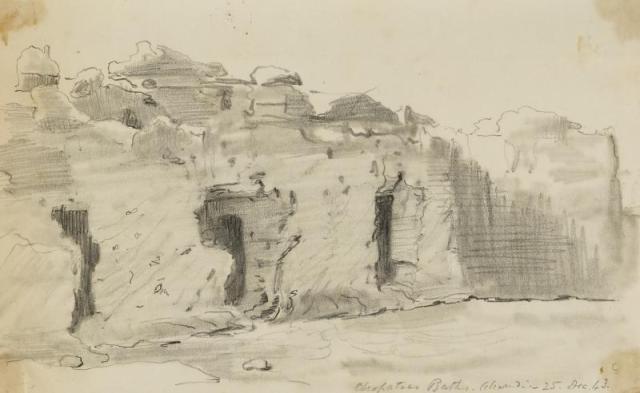
Accessed online (here) December 2020. © Smithsonian American Art Museum
John Gardner Wilkinson (1797–1875)*
A Handbook for Travellers in Egypt (A new edition, with corrections and additions, London, 1867), p. 88. Accessed online (here) December 2020.
“Nothing which remains of Alexandria attest its greatness more than the catacombs upon the coast to the westward. The entrance to them is close to a spot once covered with the habitations and gardens of the town, or suburb of the city, which, from the neighbouring tombs, was called the Necropolis. The extent of these catacombs is remarkable; but the principal inducement to visit them is the elegance and symmetry of the architecture in one of the chambers, having a Doric entablature and mouldings, in good Greek taste, which is not to be met with in any other part of Egypt.
Tapers, a basket of provisions, and, if the traveller intends to penetrate far into them, a rope, are necessary; and if he wishes to take measurements of the mouldings, a ladder. He may go either by land or water. The distance from the Frank quarter is about 2¾ miles. On the way he will pass several tombs at the water’s edge, some of which are below the level of the sea, and having been mistaken for baths have received the name of “Bagni di Cleopatra” If he happens to be remaining on board a yacht in the harbour, he will do well to take advantage of that time to visit them, as it will save a portion of the distance.
There are other catacombs to the east, which I shall mention presently (Rte. 2).”
Karl Baedeker (Firm)
Egypt: handbook for travellers. PART FIRST: LOWER EGYPT, WITH THE FAYUM AND THE PENINSULA OF SINAI (Leipzig, KARL BAEDEKER, 1878), p.220. Accessed online (here) December 2020.
In the friable limestone of the coast-hills are a number of tomb-chambers, the ceilings of which are borne by pillars of the rock left for the purpose ; but most of them have been destroyed by the inroads of the sea, and are now covered up. These chambers, which contain nothing interesting, have been styled the Baths of Cleopatra.
George Ebers (1837-1898)
Egypt: Descriptive, Historical, and Picturesque. Volume 1 (New York, Cassell & Company, Limited, 1878).
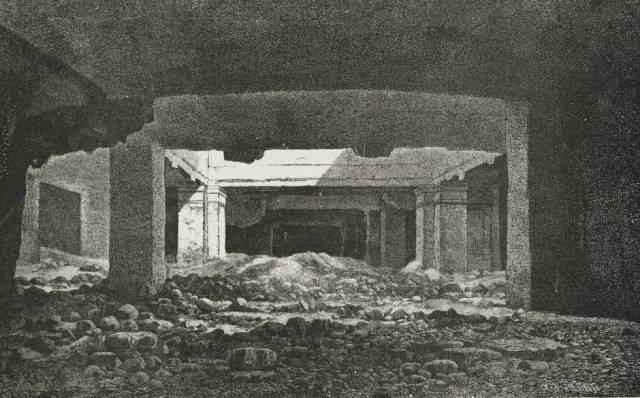
Image via Wikimedia Commons (here).
*I’m not 100% certain that this is the Grand Catacomb at Wardian but I think it probably is, and I include it as it shows the situation at a rather later date than most of the sources given here.
Detroit Publishing Company, 1905: “Egypt. Alexandria. The Catacombs of Meks”.

Image via Wikimedia Commons (here).
‘Meks’ (or ‘Mex’) was another name for the Wardian area. This coloured photograph doesn’t show the ‘Grand Catacomb’ specifically but is nonetheless of interest for its date and general view of the coastline (compare with Mayer and Kellogg, above).

